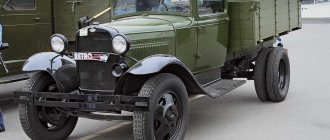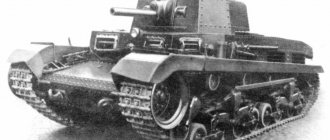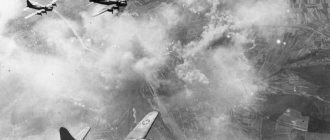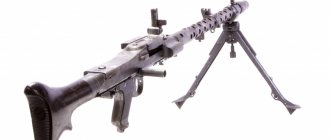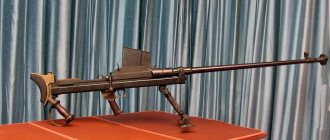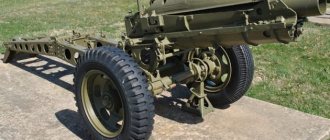Aviation ammunition | USSR
AO-2.5 fragmentation bomb
Air bomb AO-2.5-2, converted from a 45 mm artillery shell
AO-10-6.5sg fragmentation bomb converted from a 76 mm caliber projectile
AO-10 fragmentation bomb
Drawing of the AO-10sch aerial bomb
AO-15 fragmentation bomb
AO-25M air bomb under the wing of a La-5FN fighter
Drawing of the AO-25M13 bomb
During the war, the USSR used fragmentation bombs weighing 2.5, 5, 10, 15, 20 and 25 kg. At the same time, bombs were divided into specially made ones (with bodies made of steel cast iron and steel casting) and those converted from artillery ammunition (due to the lack of air bombs). Specially made bombs included:
| Bomb performance characteristics/designation | AO-2.5 | AO-2.5sch | AO-8M | AO-10 | AOX-10 | AOX-15 | AO-20M |
| Bomb length, mm | 370 | 378 | 480 | 612 | 480 | 610 | 1030 |
| Case diameter, mm | 45 | 52 | 76 | 90 | 90 | 107 | 106 |
| Bomb mass, kg | 2,5 | 2,5 | 5 | 10 | 10 | 15 | 20 |
| Stabilizer span, mm | 61 | 60 | 100 | 125 | 110 | 125 | 130 |
| Damage radius, m | 7-11 | 12 | 15 | 18 | 18 | 20 | 25 |
Bombs converted from artillery ammunition included:
| Air bomb designation | Weight (kg) | Original ammunition |
| AO-2.5-2 | 2 | 45 mm artillery shell |
| AO-2.5-3 | 3 | 82 mm mine |
| AO-10-6.5 sg | 6,5 | 76 mm artillery shell |
| AO-25-20 | 20 | 107 mm artillery shell |
| AO-25M1/M2 | 25 | 122 mm artillery shells |
| AO-25M13 | 25 | 132 mm high-explosive fragmentation rocket projectile |
The conversion of artillery shells into aerial bombs began in 1941 and consisted of equipping them with a stamped iron stabilizer (feather or box-shaped) and aircraft fuses. The bombs were dropped from a height of 150 - 350 m. Many bombs were equipped with an AV-4 rotator, thanks to which the bomb fuse was triggered above the ground, thereby increasing the area affected by fragments. Bombs weighing 2.5 kg were usually used as submunitions - they were equipped with containers (cluster bombs).
Drawing of a FAB-50 bomb
Air bomb FAB-50
FAB-50 aircraft bombs were produced in a wide range: FAB-50sv (welded, produced in 1932-1939); FAB-50sv (body made of gray cast iron); FAB-50sl (produced since 1940, cast steel); FAB-50tsk (solid forged); FAB-50shg (produced since 1943 with a stamped head); FAB-50-M43 (produced since 1943 with a simplified design and manufacturing technology). In addition, since 1936, 260 thousand 152-mm high-explosive shells from obsolete guns were converted into FAB-50m bombs by equipping them with four stabilizers and an aircraft fuse. Despite the fact that the bomb was officially designated as a high-explosive bomb, it was actually a high-explosive fragmentation bomb. All bombs were equipped with instantaneous fuses, some with a delay of 0.3 s. Bombs were used by both bombers and fighter aircraft. Performance characteristics of the bomb: length – 936 mm; diameter – 219 mm; weight – 50 – 60 kg; explosive mass – 25 kg; wall thickness – 8-9 mm; tail span – 210 – 264 mm; armor penetration - up to 30 mm of deck armor, 900 mm of brickwork or 220 mm of reinforced concrete.
Figure FAB-70m2
Air bomb FAB-70m1
In 1929-1932 FAB-70m1 and FAB-70m2 bombs were produced, which were a conversion of captured ammunition from French 240-mm mortars. The first version of the bomb was released without reloading, the second - with reloading. The modification of the mines consisted of installing a yoke for their suspension on horizontal bomb racks and equipping them with an aircraft fuse. Since 1936, bombs were produced under the designation FAB-70, which were 203-mm high-explosive shells from obsolete guns with four welded stabilizers. TTX FAB-70m2: length – 1305 mm; body length – 855 mm; diameter – 240 mm; stabilizer span – 310 mm; weight – 70 kg; explosive mass – 34 kg.
Air bomb FAB-100
During the war, FAB-100 aerial bombs were produced in the following nomenclature: FAB-100 (produced since 1932), FAB-100tsk (produced since 1938, solid forged), FAB-100M (produced since 1942), FAB-100sv (welded), FAB-100 KD (produced in 1941-1944, equipped with an explosive liquid mixture); FAB-100NG (produced since 1941, body made of thin-walled reinforced concrete), FAB-100 M-43 (produced since 1943, simplified design and manufacturing technology), FAB-100sch (produced since 1944, body made of gray cast iron ), FAB-100sl (produced since 1944, cast steel body). All bombs were equipped with instantaneous fuses, some with a delay of 0.3 s. Performance characteristics of the bomb: length – 964 mm; diameter – 267 mm; weight – 100 kg; explosive mass – 70 kg; wall thickness – 14 mm; damage radius - 18 m.
Air bomb FAB-250
250-kilogram bombs were produced in the following variants: FAB-250 (produced since 1932), FAB-250sv (produced since 1932, welded), FAB-250tsk (solid forged body), FAB-250sch (produced since 1943, gray cast iron), FAB-250NG (produced since 1941, body made of thin-walled reinforced concrete), FAB-250M-43 (produced since 1943, simplified design and manufacturing technology), FAB-250M44 (produced since 1944, with a shortened stabilizer). The bomb had a four-finned stabilizer with spacer bars. The ammunition was used to destroy civilian objects, underground communications and field defensive structures with reinforced concrete floors up to 0.4 m thick. Performance characteristics of the bomb: length - 1589 mm; diameter – 285 mm; weight – 250 kg; explosive mass – 99 kg; damage radius - 56 m.
Air bomb FAB-500
The range of 500-kilogram bombs included: FAB-500, FAB-500sv (produced in 1932-1940, welded), FAB-500M (produced in 1942-1943, with simplified manufacturing), FAB-500NG (produced since 1941 g., body made of thin-walled reinforced concrete), FAB-250M43 (produced since 1943, simplified design and manufacturing technology), FAB-500M44 (produced since 1945, with a shortened stabilizer). The bomb could be used with long-delay fuses (hours, days) for mining areas. At the same time, they were equipped with vibration and anti-removal devices that caused an explosion when the ground was shaken by a moving train, tank, etc. or when trying to defuse a bomb. When an explosion occurred at a depth of 3 - 3.5 m, a crater with a diameter of 8.5 - 16 m was formed. Performance characteristics of the bomb: length - 2.1 - 2.3 m; diameter – 392 – 447 mm; weight – 500 kg; explosive mass – 213 – 226 kg; stabilizer span – 570 – 600 mm; armor penetration - 1.2 m of concrete floor or 0.8 m of reinforced concrete; damage radius – 80 m.
Air bomb FAB-1000
During the war, the following 1000-kilogram bombs were produced: FAB-1000sv (produced in 1932-1943, welded), FAB-1000M (produced since 1942, with simplified manufacturing, box stabilizer and shorter length), FAB-1000M43 ( produced since 1943, simplified design and manufacturing technology), FAB-1000M44 (produced since 1945, with a shortened stabilizer), FAB-1000NG (produced since 1941, thin-walled reinforced concrete body), FAB-1000sl (produced since 1943 g., steel casting). The explosion at a depth of 4 m created a crater with a diameter of 17 m. Performance characteristics of the bomb: length - 2765 mm; diameter – 630 mm; weight – 1000 kg; explosive mass – 674 kg; armor penetration - 1.8 m of concrete floor or 1 m of reinforced concrete.
Air bomb FAB-1500
1500-kilogram bombs were produced in the following variants: FAB-1500, FAB-1500T and FAB-1500-2500TS. The FAB-1500-2500TS thick-walled bomb had a cast warhead with a wall thickness of about 100 mm. Weight - 2.5 tons. Performance characteristics of the bomb: length - 3 m; diameter – 642 mm; weight – 1400 kg; warhead weight - 1200 kg; explosive mass – 675 kg; wall thickness – 18 mm; damage radius – 160 m.
Air bomb FAB-2000
The FAB-2000sv bomb was put into service in 1934. It had a body of welded construction, head and bottom fuses with a delay of 0.3 s. In 1943, due to the simplification of the bomb design and manufacturing technology, the FAB-2000M-43 began to be produced. In 1945, the FAB-2000M44 was put into service. When a bomb exploded at a depth of 4 m, a crater with a diameter of 20 m was formed. Performance characteristics of the bomb: length - 4.5 m; wall thickness – 12 mm; armor penetration - 1.8 m of concrete floor or 1.2 m of reinforced concrete.
High explosive bomb FAB-5000
The bomb was an aerial bomb of welded construction and was put into service in 1943. Its steel warhead, which reached a thickness of 90 mm at the head section, was cast. The cylindrical and conical parts of the body were rolled from sheet metal, welding all joints with a double-sided seam. The cone of the box-type stabilizer on the conical part of the bomb body was pressed by a special ring of the tail bushing. The bomb had 6 fuses - one each in the head and bottom points and four side fuses set to instantaneous action. The presence of side fuses and a highly developed system of additional detonators ensured the persistence of the blast wave, which was extremely important when bombing large populated areas. The carrier of the bomb was PE-8. At the same time, the bomb bay doors closed only one third. Performance characteristics of the bomb: length – 3107 mm; diameter – 642 mm; weight – 4900 kg; explosive mass – 2207 kg.
Air bomb OFAB-100
The high-explosive aerial bomb was put into service in 1945. It was equipped with instantaneous or non-contact contact fuses, triggered at a height of 5–15 m. When the bomb exploded, a crater with a diameter of 5 m and a depth of 1.7 m was formed. Performance characteristics of the bomb: length - 1065 mm ; diameter – 273 mm; weight – 100 kg; explosive mass – 30.7 kg; damage radius – 50 m; armor penetration – 40 mm.
Air bomb BetAB
During the war, a concrete-piercing bomb BetAB-150 DS (with additional speed) with a rocket accelerator was produced to destroy objects with strong concrete or reinforced concrete protection. The warhead of the bomb was a 203-mm artillery shell. The rocket booster gave the bomb an additional speed of 210 m/s. The bomb penetrated into the marble rock mass to a depth of 1.7 m. When the bomb exploded in the ground, a crater with a diameter of 1.8 m and a depth of 2.5 m was formed. Performance characteristics of the bomb: length - 2097 mm; length – 210 mm; weight - 165 kg; warhead weight - 102 kg; explosive mass - 14.5 kg; rocket charge mass - 17.2 kg.
Air bomb BrAB
During the war, the following armor-piercing bombs were produced: BRAB-200 DS, BrAB-220, BrAB-250, BrAB-500, BrAB-1000. The BRAB-200 DS bomb had a rocket accelerator, which gave the bomb an additional speed of 180 m/s. The bomb was made on the basis of “marine” 203 mm semi-armor-piercing artillery shells without a rear part, to which a streamlined cone with a bottom fuse and a large four-finned stabilizer was attached to the rear. Performance characteristics of the BrAB-200 bomb: length – 2054 mm; length – 278 mm; weight – 213 kg; warhead weight - 150 kg; explosive mass – 12.3 kg; rocket charge mass - 19.2 kg; armor penetration - 182-260 mm. The BRAB-500 and 2BRAB-1000 bombs were equipped with biconical anti-ricochet tips. The bodies of the new armor-piercing aerial bombs were made by stamping from alloy steel followed by mechanical and heat treatment and had a conical shape, tapering towards the tail section. The warheads of the bombs were cast from high-alloy steel. The stabilizer wings were riveted to the conical fairings using steel angles. To be placed on the external horizontal bomb racks of aircraft, air bombs were equipped with main and additional yokes with hanging lugs of the corresponding weight groups. The performance characteristics of the bombs are shown in the table.
| Bomb performance characteristics/designation | BrAB-220 | BrAB-250 | BrAB-500 | BrAB-1000 |
| Weight, kg | 238 | 255 | 502-510 | 965-1 012 |
| Explosive mass, kg | 38 | 31,3 | 65,5-106 | 131-207 |
| Length, mm | 1 680 | 1 828–1 841 | 2 313–2 385 | 2 789- 075 |
| Diameter, mm | 278 | 220 | 277-400 | 356-480 |
| Stabilizer span, mm | 370 | n/a | 390-400 | 480 |
Incendiary bomb ZAB-2.5t
KD-1-8 cassette with ZAB-10TG bombs
Drawing of an incendiary bomb "ZAB-50tg"
Drawing of an incendiary bomb ZAB-100 tsh
By the beginning of the war, only small and medium caliber incendiary bombs were produced in the USSR - ZAB-1e, ZAB-2.5t, ZAB-10tg and ZAB-50tg. In 1941-1944. A small number of large-caliber incendiary bombs ZAB-100 and ZAB-500 were fired. All of them belonged to ammunition of intense and concentrated action. Their common drawback was that they were only effective if they hit the target directly, and they could easily be extinguished. The ZAB-1e and ZAB-2.5t bombs belonged to the category of submunitions - they were equipped with RRAB rotary-dispersal aerial bombs, and were also dropped in groups from cassette buckets. Incendiary bombs of 1.5–2.5 kg caliber are filled with thermite compounds. Bombs with a caliber of more than 10 kg were considered ammunition for individual use - on the aircraft they were placed on the locks of bomb racks and dropped during a single, serial or salvo bombing. A total of 5.8 million incendiary bombs of all types were fired.
Incendiary aircraft bomb ZAB-500
The bomb was intended to destroy targets using a thickened incendiary mixture with a high combustion temperature (gasoline, kerosene, toluene). The thickened fire mixture was crushed by an explosion into large pieces, which were scattered over long distances and burned at a temperature of 1000–1200°C for several minutes. The fire mixture stuck to various surfaces and was difficult to remove from them. Combustion occurred due to the oxygen in the air, so a significant amount of poisonous carbon dioxide was formed within the radius of the bomb. To increase the combustion temperature of the fire mixture to 2000–2500°C, combustible metal powders were added to it. Thanks to its durable casing, the bomb was capable of breaking through the walls and roofs of buildings, hitting the interior. The main targets for the ZAB-500 were aircraft in parking lots, cars, radar installations, small buildings and enemy personnel. The minimum permissible altitude for use is 750 m. A total of 3.5 thousand units were produced. Performance characteristics of the bomb: weight – 500 kg; warhead weight - 480 kg; length – 2142 mm; diameter – 321 mm.
Incendiary ampoules AZh-2 with additional fuses
Container ABK-P-500 with incendiary ampoules AZh-2K
Aviation liquid tin ampoules AZh-2 of 125 mm caliber, filled with self-igniting condensed kerosene of the KS brand, replaced AK-1 glass ampoules and were produced since 1936. They were made by stamping two hemispheres from thin brass 0.35 mm thick, and since 1937 with tinplate 0.2-0.3 mm thick. The configuration of parts for the production of tin ampoules varied greatly. In 1937, production consisted of AZh-2, consisting of a hemisphere with a filler neck and a second hemisphere of four spherical segments. At the beginning of 1941, technologies for producing AZh-2 from black tin (thin rolled 0.5 mm pickled iron) were tested. The parts of the AZh-2 housings began to be connected by rolling up the edges and recessing the seam flush with the contour of the sphere. In 1943, the ampoules were supplemented with fuses made of thermosetting plastic. When encountering a solid barrier, the body of the AZH-2KS ampoule burst, as a rule, at the adhesive seams, the incendiary mixture splashed out and ignited in the air, producing thick white smoke. The combustion temperature of the mixture reached 800°C. Along with AZh-2, a modification with increased capacity was used - two-liter ampoules "AZh-4" in balls with a diameter of 260 mm. The ampoules were loaded into special containers (cassettes) of small bombs. In total, about 6 million ampoules of various modifications were produced. TTX AZH-2: total weight - without fuse - 1.5 kg, with fuse - 1.9 kg, total capacity - 0.9 l.
Anti-tank bomb PTAB-2.5
The bomb with a shaped charge was intended to destroy armored vehicles. Bombs were first used in 1943 in the Battle of Kursk. Bomb bodies and riveted pinnate-cylindrical stabilizers were made of sheet steel 0.6 mm thick. To increase the fragmentation effect, a 1.5-mm steel jacket was additionally put on the cylindrical part of the aerial bombs. The fuse is bottom. The bombs were loaded into cassettes ranging from 22 to 86 pieces, depending on the type of container. The maximum number of bombs could be placed in the universal bomb bay of the Il-2 attack aircraft (280 pieces). The minimum bombing height is 70 m. A total of 14.6 million bombs were manufactured during the war. Performance characteristics of the bomb: weight – 2.5 kg; explosive mass – 1.5 kg; length – 355-361 mm; armor penetration - 60 mm at an encounter angle of 30° and 100 mm at 90°.
Drawing of the PLAB-100 aerial bomb
The PLAB-100 anti-submarine bomb was put into service in 1941. It was intended to destroy submarines from altitudes of 300-800 m. The bomb consisted of a body, a parachute box with a parachute and a release mechanism. When dropping a bomb from an airplane, the release line, tearing off the cover, removed the brake parachute from the box and launched the firecracker retardants of the release mechanism. After 4-5 seconds it was triggered, releasing the ammunition from the braking parachute and its transport box. Suspension – vertical. Performance characteristics of the bomb: length – 1046 – 1062 mm; diameter - 290 mm; stabilizer span - 310 mm; weight - 100 kg; explosive mass - 70 kg; wall thickness – 3 mm.
Air bomb ANAB-2
An auxiliary aeronautical naval bomb, produced since 1936, which served to visually fix the starting point on the water surface when measuring drift angles and ground speed. In addition, they were used to set an “auxiliary aiming point” on the ground and mark a given point on the water surface. The ANAB was transported in the navigator's cabin and dropped manually. The head part of the bomb was made of 0.25 mm tinplate, the tail part was made of 0.75 mm decapitated iron, and consisted of two chambers separated by a diaphragm - a float chamber and a chamber for equipment. An ogival-shaped float chamber with a welded stabilizer was equipped with gas exhaust tubes. The head parts were filled with a solution of fluorescein in acetone and calcium phosphorous (day-use equipment), and the filler hole was closed with a lid and sealed. When it hit the water surface, the head part broke, the released load sank, and the liquid, spreading over the surface of the water, formed a bright greenish-yellow spot 9-10 m long. The tail part floated up after 2-3 seconds and, having received water through the tube and the bottom hole , “triggered” the decomposition reaction of calcium phosphorous. This produced liquid hydrogen phosphorous, which ignited in air and ignited the phosphine mixture. The combustion was accompanied by the release of white smoke. In addition, the white-yellow flame had the appearance of a torch 20–25 cm high with a burning duration of 1–1.5 minutes, after which flashes could be observed for another 10–15 minutes at intervals of 5–15 s.
Drawing of the hydrostatic bomb GAB-100D
Hydrostatic (floating) munitions were intended for setting up camouflage smoke screens at sea in order to cover the attacks and maneuvers of their ships. In 1939, the PAB-100 aerial bomb was put into service. In 1944, the ammunition received the name GAB-100D. The body of the aerial bomb consisted of two transverse halves connected to each other by a thread. The front part contained the smoke mixture, and the rear part served as a float chamber. The bomb was dropped with a special parachute. The fuse is instantaneous. Performance characteristics of the bomb: charge weight - 40 kg; Smoke formation time is 7 - 10 minutes.
Drawing of a smoke bomb DAB-100-80f
During the war, two smoke aerial bombs were in service: DAB-25 and DAB-100. Since 1944, they received the designation DAB-25-30F and DAB-100-80F. The ammunition was intended to place camouflage smoke screens on the ground in order to cover the attacks and maneuvers of friendly troops, as well as to blind the enemy’s defense fire system (aircraft controllers and artillery fire spotters). The ammunition was manufactured in welded cases, stamped and rolled from sheet steel. The plumage is four-pinnate, the fuse is instantaneous. TTX DAB-25-30F: weight – 15 kg; charge weight – 17 kg of white phosphorus; diameter – 203 mm; wall thickness – 4 mm; Smoke formation time is 3 - 5 minutes. TTX DAB-100-80F: weight – 100 kg; wall thickness – 3 mm; smoke formation time - 5 - 10 minutes; smoke screen length – 100 – 1500 m; curtain height – 50 – 80 m.
SAB-3M flare bomb
Drawing of the SAB-100-55 flare bomb
Illuminating (luminous) aerial bombs, related to auxiliary ammunition, were used in night operations of reconnaissance and bomber aircraft during visual reconnaissance and illumination of the area during targeted bombing, in joint actions of aviation with naval ships and aviation with artillery. The latter consisted of adjusting artillery fire from aircraft, guiding ships and submarines at night at the enemy fleet, bombers at targets, as well as illuminating the area when aircraft landed outside airfields. During the war, the USSR produced four types of flare bombs: SAB-3 and SAB-3M, SAB-50-15, SAB-100-55. The bomb consisted of three main components: a body made of thin sheet steel, a pyrotechnic lighting torch in a paper sleeve, and a parachute. When a bomb is dropped at a given distance, the pyrotechnic torch ignites and, together with the parachute, is pushed out of the body of the bomb by the pressure of the powder gases. A burning torch ejected from the hull slowly descends by parachute, illuminating the area. The most common bomb SAB-50-15 (2,000,000 - 2,200,000 candles) used at an altitude of 2000 m created a light spot within a radius of 3000 m. The burning time was about 4.5 minutes. Weight – 55 kg; Case thickness – 04 mm. A total of 602 thousand flare bombs of all types were produced during the war.
Photo-illuminating bomb FOTAB-50-35
The aerial bomb was a source of light for night aerial photography. It was a charge of a pyrotechnic composition, enclosed in the shell of an aircraft bomb and producing a powerful flash. This illumination was sufficient to obtain high-quality aerial photographs from altitudes of up to 7,500 m at night. Sometimes the bomb was used in the middle of the night to suppress anti-aircraft gunners with a powerful flash. Performance characteristics of the bomb: maximum luminous intensity – 500 million candles; flash duration – 0.1 - 0.2 s; fall time – 27 s; length – 890 mm; weight – 35 kg; diameter – 203 mm.
Drawing of the AGB-100-30 propaganda bomb
Propaganda bombs were intended to scatter leaflets and other propaganda materials on enemy territory. The bomb consisted of: a hollow, collapsible body, which was filled with leaflets before use; expelling charge for pushing out propaganda materials; a remote fuse that ensures that the expelling charge is triggered at a certain distance or height. The bomb was created in the dimensions of the FAB-100. Its body was made of plywood and weighed no more than 20 kg. A pipe with a powder firecracker was installed along the hull, allowing the hull to be opened at a given height by an explosion. The bomb was equipped with leaflets in the form of rolls weighing 2.7 - 3.2 kg each. The leaflet had a format of 206x146 mm. They dropped the bomb from both external and internal bomb racks. Depending on the weather, the discharge height ranged from 50 to 500 m.
RRAB container
To use small high-explosive, fragmentation, incendiary and other aerial bombs weighing 1-2.5 kg, the USSR developed various carriers - stationary cassettes, containers and RRAB (rotational dispersal aerial bombs). The ammunition was installed by the tail at 45º to the main longitudinal axis. When dropped, the ammunition gained rotational motion with increasing frequency. When a given speed of rotational movement was reached, the cables, which had weakened sections, tightening the body, began to break due to the action of centrifugal forces, and small military ammunition began to dissipate, hitting a large area when falling. RRAB was manufactured in three versions: up to one thousand kilograms (RRAB-1); up to half a ton (RRAB-2); up to 250 kilograms (RRAB-3). Structurally, RRABs are a shell with thin walls, into which small aerial bombs were placed by equipment directly at the airfield, just before use. All RRABs were of a similar design: RRAB-1 contained: 84-130 bombs of the AO-8 type, 100 of the AO-10 type, 50 of the AO, 260 of the AO-2.5. RRAB-2 contained: 50-78 AO-8 bombs, 66 ZAB-10, 25 AO-20, 260 AO-2.5. RRAB-3 carried 34 AO-8 bombs, 25 – ZAB-10 or AO-10, 18 – AO-20, 116-AO 2.5, 126 – PTAB-2.5.
RS-82 rockets
Guides from RS-82 under the wing of an Il-2 attack aircraft
RS-132
Pe-2 with a suspension of ten PC-132 rockets
The RS-82 air-to-air missile was first used in 1939 by I-16 fighters during the defeat of Japanese troops on the Khalkhin Gol River.
By 1942, industrial launchers for I-153, SB and IL-2 aircraft were created. During the Soviet-Finnish War (1939-1940), 6 twin-engine SB bombers were equipped with launchers for PC-132 (air-to-ground) missiles. The effectiveness of using rockets in air combat, as well as when firing at single ground targets (tanks, cars, etc.) was extremely low, so they were used for salvo firing at areas. The projectile consisted of a head warhead and a reactive part (powder jet engine). The warhead was equipped with an explosive charge, which was detonated using contact or non-contact fuses. The jet engine had a combustion chamber in which a propellant charge was placed in the form of cylindrical blocks of smokeless powder with an axial channel. Stabilization of the projectile in flight was ensured using a tail stabilizer made of four stamped steel feathers. The projectile head is blunt, with cuts on the ogive. In 1935-1936 PC-82 missiles were launched from yoke-type aircraft launchers, which had high drag and significantly reduced the speed of the aircraft. In 1937, a groove-type guide was developed with a single bar having a T-shaped slot for projectile guide pins. Later, in launchers for the PC-132, the support beam-pipe was abandoned and replaced with a U-shaped profile. The use of groove-type launchers significantly improved the aerodynamic and operational characteristics of projectiles, simplified their production, and ensured high reliability of projectile deflection. In 1942, aircraft projectiles PC-82 and PC-132 were modernized and received the indices M-8 and M-13. TTX RS-82: caliber – 82 mm; projectile length – 600 mm; explosive mass – 360 g; rocket fuel weight - 1.1 kg; total projectile mass - 6.8 kg; speed – 340 m/s; range – 6.2 km; radius of continuous fragmentation damage - 6-7 m. Performance characteristics of the RS-132: caliber - 132 mm; projectile length – 845 mm; explosive mass – 900 g; rocket fuel weight - 3.8 kg; total projectile mass - 23 kg; speed – 350 m/s; range – 7.1 km; the radius of continuous fragmentation damage is 9-10 m. The following modifications of the RS-82 are known: RBS-82 (armor-piercing version, armor penetration up to 50 mm); ROS-82 (rocket fragmentation projectile); ROFS-82 (version with high-explosive fragmentation warhead); ZS-82 (incendiary RS); TRS-82 (turbojet). RS-132 had the following modifications: BRS-132 (armor-piercing version, armor penetration up to 75 mm); ROFS-132 (version with high-explosive fragmentation warhead); ROS-132 (fragmentation projectile); ZS-132 (incendiary projectile); TRS-132 (turbojet). Share to:
The Soviet Tsar Bomb who broke the will of the Nazis
Super-heavy bombs dropped on military infrastructure could cause catastrophic damage and change the situation on the fronts, leaving the enemy without ammunition, modern weapons systems, equipment and fuel. And the Soviet FAB-5000NG became a bright “strawberry” on the cake of the overall victory in the Great Patriotic War.
Subscribe and read Express Newspaper in:
Before the era of jet systems, throwing high-explosive bombs filled with large amounts of TNT or other explosive mixture was the most effective means of destroying enemy strategic infrastructure. Under the blows of multi-ton ammunition, thick-walled reinforced concrete ceilings of military factories were shattered and secret command posts were completely destroyed.
Precisely dropped from a great height, the bomb was capable of piercing several armored decks of enemy battleships with its own weight. And the explosion of ammunition caused terrible destruction in the hold, leading to the detonation of ammunition and the death of the ship.
A kind of bomb arms race took place on the eve of and during the Second World War. At that time, potential and real opponents developed dozens of models of super-powerful bombs that were used to perform certain tasks.
"Baby" by Neeson Gelperin
During the Great Patriotic War, Soviet engineers were tasked with creating a super-powerful bomb, which a team of like-minded people under the leadership of Nison Gelperin .
Initially, an attempt was made to construct a flying bomb-projectile from an obsolete TB-3 bomber. A kind of first cruise missile was supposed to be radio-controlled and resemble modern attack drones. But the technology of that time did not allow this idea to be brought to life.
Gelperin's design bureau presented the state commission with a sample of the FAB-5000NG bomb, which has a length of 5.2 meters and a diameter of 1 meter. The ammunition was filled with 3,200 kilograms of an “explosive” explosive mixture consisting of trinitrotoluene, hexogen and aluminum in a unique proportion.
The high-explosive bomb had a dead weight of about 5,400 kilograms. Only one Pe-8 bomber, which had a maximum payload of about four and a half tons, was capable of carrying it on board - and even then the result was an overload of a whole ton.
FAB-5000NG before testing
Mother of colossal destruction
The first use of the Tsar Bomb dates back to April 28, 1943, when Soviet bombers attacked the coastal fortifications of the Koenigsberg fortress. The effect was stunning, since the Germans did not expect such impudence from the Russians and were unprepared to repel an air attack.
Unfortunately, further attempts to use the FAB-5000NG to bomb strategic targets deep behind enemy lines were unsuccessful. Pe-8 bombers with such an overload significantly lost speed and maneuverability, becoming easy targets for enemy fighter aircraft.
Despite this, the most powerful aerial bomb of the USSR continued to be successfully used when striking military targets located in close proximity to the front line. As a rule, a squadron of bombers was accompanied by several flights of Lavochkins or Yakovs, and Il-2 “flying tanks” were used to destroy enemy anti-aircraft batteries.
A powerful argument
It is known about the strikes with a superbomb on concentrations of fascist troops during the Battle of Kursk and the liberation of Orel. After the start of the victorious march of the Red Army across Ukraine and Western Europe, FAB-5000NG was repeatedly dropped on transport hubs, paralyzing railway traffic for several days and destroying dozens of wagons with military equipment.
In February 1944, two such Tsar Bombs were dropped on Helsinki, the capital of Finland, which was an ally of Germany. According to one version, it was this bomb attack that forced Baron Mannerheim, who was the long-time leader of Finland, to enter into peace negotiations with the USSR. Finland admitted its defeat and withdrew from the war, and the released military units of the Red Army set out to liberate the Baltic states from the Nazis.
At the beginning of 1945, the fortified areas of Konigsberg again felt the terrifying power of the FAB-5000NG. Their explosions left huge gaps in the walls of the ancient fortress and forced entire fascist units to surrender.
Afghan training ground
At the end of the Great Patriotic War, the use of such heavy-duty bombs was temporarily suspended. Although there is officially unconfirmed information that the FAB-5000NG and its “descendants” were repeatedly dropped on the defensive structures of the Mujahideen in Afghanistan.
Historians of this war claim that in Afghanistan the Soviet Army initially used the most powerful Soviet non-nuclear munitions - FAB-9000 M54 high-explosive bombs, which were delivered to targets by Tu-16 strategic bombers, to bomb fortified rebel positions.
The weight of this monster reached 9407 kilograms, and the explosive filling consisted of 4297 kg of a special TNT mixture. Despite the enormous power of the explosion and the strong blast wave, the use of such bombs in mountainous areas was considered insufficiently effective: the cost of the ammunition significantly exceeded the cost of the damage caused. It was then that the command decided to use the reserves of the “old ladies” FAB-5000NG, which were easily delivered to targets.
They destroyed the labyrinths of command posts, as well as carefully disguised weapons and ammunition warehouses, inflicting serious damage on the Mujahideen.
Remain in service
After the withdrawal of Soviet troops from Afghanistan, heavy-duty aerial bombs were not officially used by the troops of the USSR and the Russian Federation. They were replaced by the tactics of delivering concentrated missile strikes against targets using guided missiles. However, due to the relative cheapness and the availability of effective means of delivering them to the target, the use of super-heavy aerial bombs potentially continues to be an effective means of destroying the enemy.
The events that took place in Syria last year once again proved that precise bombing can break the spirit of the enemy and put him to flight. And Russian strikes on military targets and terrorist enterprises made it possible to completely turn the tide of the civil war in this country, liberating its largest cities.
It is quite possible that among the “air gifts” that fell on the heads of the terrorists were the well-proven FAB-5000NG and FAB-9000 M54.
Roman Zablotsky
WWII bomb military correspondent Interesting history Russian weapons



